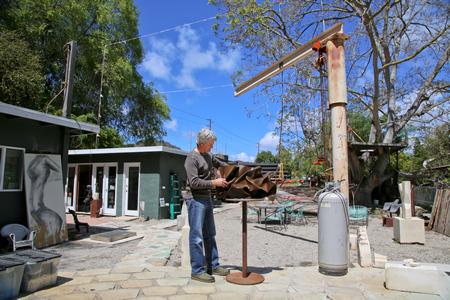Residents thronged City Hall on Tuesday to weigh in on local sculptor Louis Longi’s artists’ work/live project, the source of months of controversy. Proponents sported bright red t-shirts, while vivid green “Save Laguna Canyon” lapel stickers indicated opponents.

Ultimately, the red shirts carried the day with a City Council vote of 3-2, effectively giving the project a green light. The vote officially denied an appeal and upheld the Planning Commission’s earlier approval of permits for the 30-unit structure proposed for 20412 and 20432 Laguna Canyon Road.
Mayor Pro Tem Bob Whalen and Council member Toni Iseman dissented.
More than 60 people spoke on the project, espousing views nearly equally divided into opposite camps.
Detractors focused largely on the project’s size and impact on the Sun Valley Drive neighborhood, as well as concerns about flooding, traffic and establishing a precedent for canyon urbanization that contradicts development policies of the area’s specific plan.
Their neighborhood character “would be forever dominated by this structure,” declared appellant John Albritton, president of the Laguna Canyon Property Association.
Former council member Verna Rollinger said approval of Longi’s project would break a promise by violating the city’s own annexation plan for the area. “Tonight we have the opportunity to find out what the city’s word is worth,” she said.
Proponents claimed the project was vital to preserving the town’s character by halting the exodus of local artists and not incompatible with the neighborhood or the canyon’s character. They saw it as establishing a positive precedent for the sort of development the town lacks.
Longi’s investment partner Chris Dornan said the project complies with all of the city’s codes and regulations, without any need for variances, and defended its place in the canyon. He called it a rare opportunity to make a difference in the community where he was born and raised.
“We are losing our artists to surrounding, more affordable communities,” he said, a sentiment shared by numerous supporters.
In light of a flurry of staked projects in the canyon, such as a storage facility planned at Big Bend and proposed permanent supportive housing by the dog park, speakers on both sides of the issue expressed a need for a more comprehensive canyon development plan.
As soon-to-retire principal planner Carolyn Martin explained, the Planning Commission approved the project in a 3-2 vote on Jan. 8, after three public hearings and a number of requested revisions. The 37,000 square foot project, including two buildings of two levels above a parking garage, lies within the M1-B light industrial zone of the Laguna Canyon Annexation Area Specific Plan.
The plan’s policy requires development to be of small scale and of a rural character, which competes with the specific plan’s M1-B development standards, she said. The latter allow a 36-foot height limit, larger than surrounding structures, because of current federal regulations that buildings be elevated above the flood plain, Martin said, adding that were any existing buildings to be reconstructed, they would require similar elevation.
She further noted that the M1-B zone is located only in the Laguna Canyon annexation area and that “small scale is not defined or quantified in the specific plan.”
Council member Steve Dicterow said the neighborhood changes do set a sort of precedent since zoning conflicts with largely residential properties built years ago, now designated as legal non-conforming.
The scale concerned Whalen, particularly given some “very legitimate differences of opinion,” and he called for putting off a vote so that staff might work with Longi to perhaps reduce the project’s scale and develop a subsidy that would allow a smaller project to be financially viable.
Iseman fell in step with Whalen. She also questioned whether the units would be truly affordable for artists and whether their use was truly vetted. She also agreed with Albritton’s testimony that the project’s scale justified a full-fledged environmental impact report.
Council member Kelly Boyd discounted traffic concerns, noting that artists working where they live won’t generate as many trips as generated by the nearby Anneliese’s school and Canyon Club. He believed people would accept the project once it is completed and fully landscaped, much the way that many former detractors of the Montage resort development now walk their dogs in the resort-maintained public park. “I’m not a progressive person,” said Boyd, “but sometimes you have to have changes.”
Mayor Elizabeth Pearson decried as “pathetic” the fact that just a dozen live/work units have been provided citywide for artists in the past 14 years. She viewed the project as “more rural than most of the stuff that’s out there.”
Even so, she conceded that the controversy over Longi’s project, while other large projects wait in the wings, highlighted the need for city officials to tackle more comprehensive planning. “We’ve got to get a hold of this whole canyon all the way into town,” she said. No one disagreed.





Yes! Artists lofts are a welcomed addition to the canyon….but a STORAGE facility…? Really? Isn’t there bester use of this prime spot? Where are the throngs of individuals who should be protesting a big box filled with little boxes(rooms) and even further boxes(usually junk..) in storage??? Now THAT is what I consider city blight!
Big Bend would have been a delightful spot for parking and jumping on a light rail to Forest to shop or to the beach to drop……
[…] controversial approval of Longi’s project locally last April sparked a heated public debate on the direction of […]
[…] appeals to the Coastal Commission that challenged the approval of Longi’s project by the City Council and the Planning Commission last year. The overlapping claims included contentions that the […]